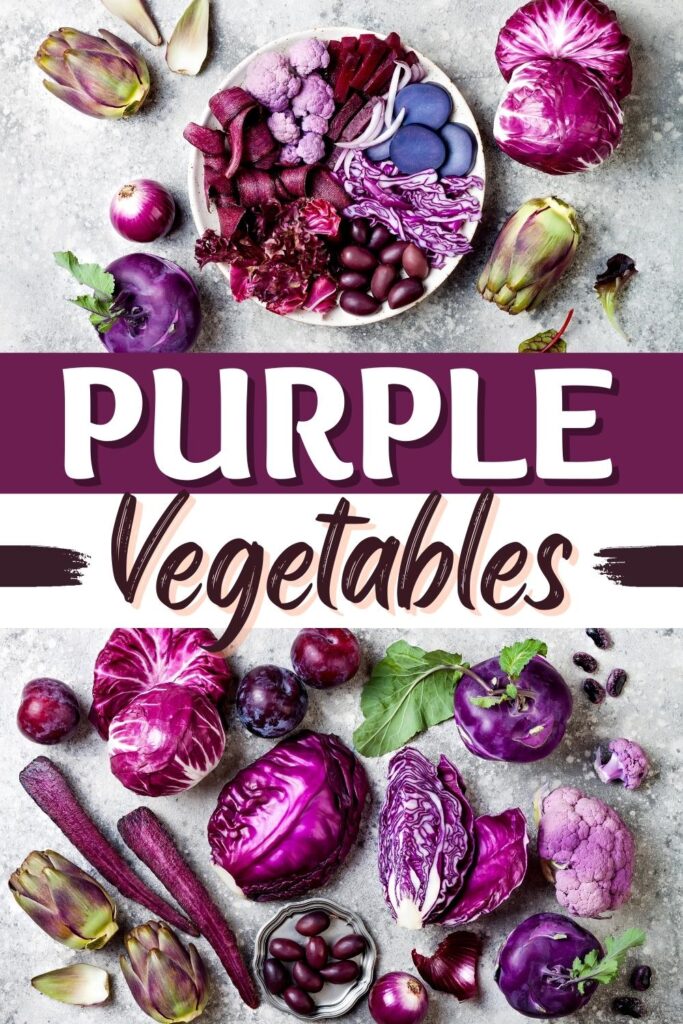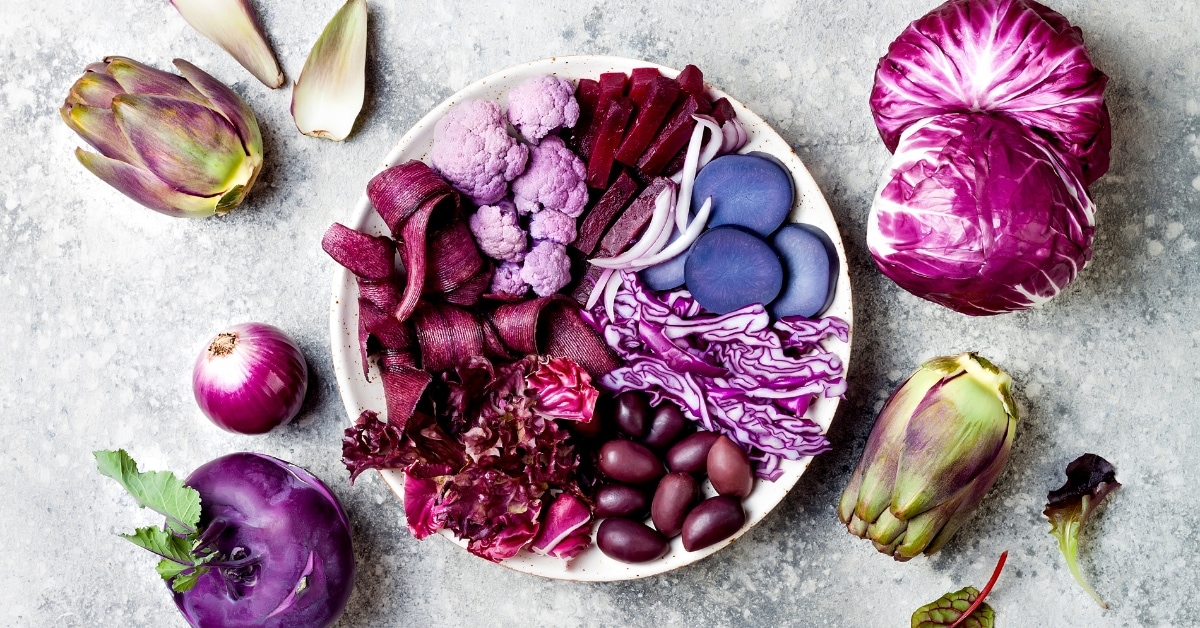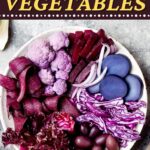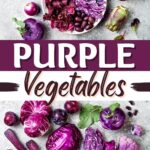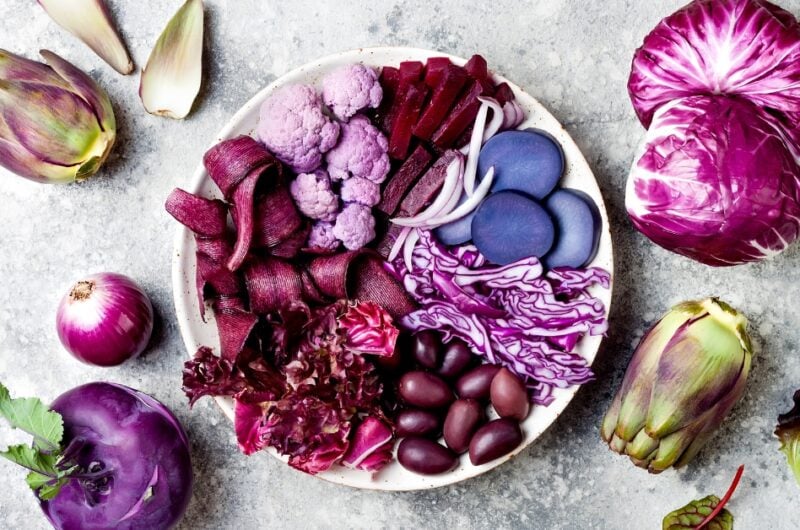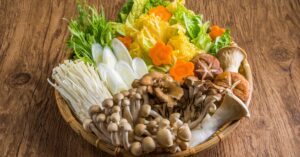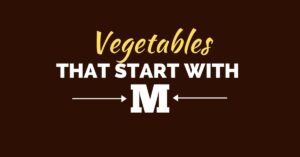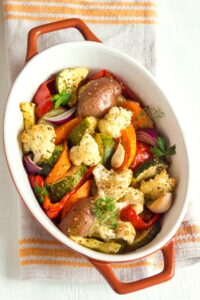Adding purple vegetables to your diet makes it easy to eat the rainbow.
If you’re unfamiliar with the healthy eating practice, experts recommend filling your plate with varying colors of fruits and veggies.
That way, you can consume a wide variety of nutrients and vitamins from all sorts of produce.
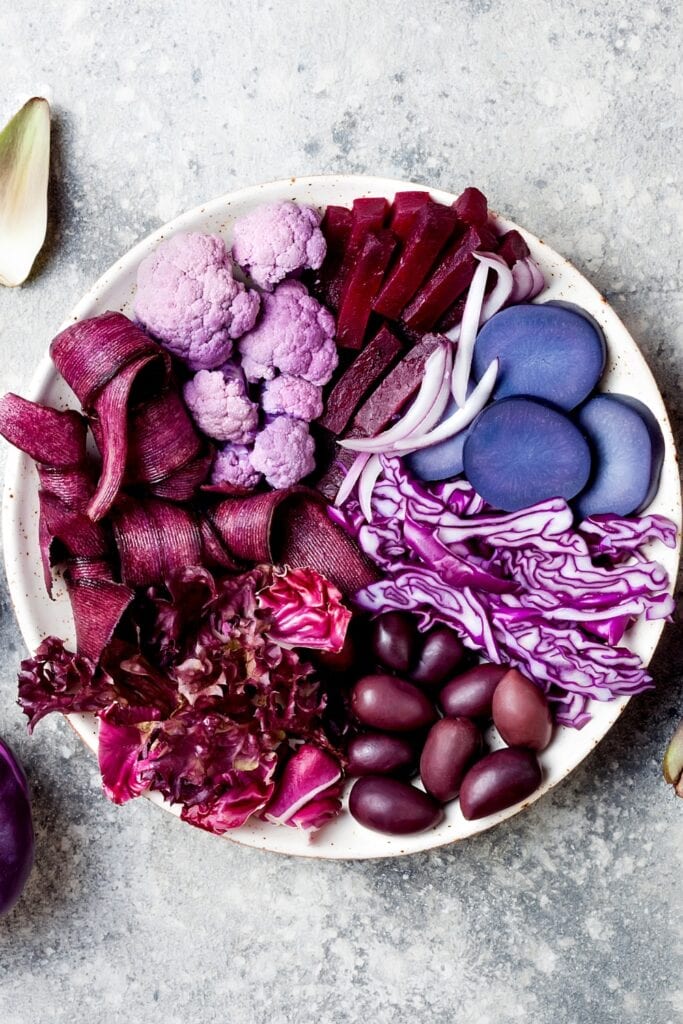
You might already know some of these purple vegetables, like eggplant and purple cabbage.
But I hope you’ll discover some new varieties on this list.
Below, you’ll find 23 types of purple vegetables to spark your culinary curiosity.
Benefits of Purple Foods
Purple vegetables aren’t just easy on the eyes. They’re also incredibly healthy and full of good-for-you properties.
The pretty purple color comes from anthocyanins, a natural plant pigment that creates a lovely violet hue.
You can find this naturally occurring property in blueberries, blackberries, red cabbage, and more.
Anthocyanins have rich antioxidant properties, which have a variety of benefits for maintaining overall health.
A diet rich in anthocyanins may help lower blood pressure, reduce the risk of heart disease, and prevent neurological disorders.
23 Best Purple Vegetables
1. Eggplant

Aside from providing the perfect vegetarian alternative to chicken parmesan, eggplant has many other uses.
The spongy texture makes it a mainstay in saucy dishes since it soaks up flavors nicely.
The mild taste creates a great blank slate for seasoning.
You’ll find many varieties of eggplants ranging in color from purple, red, black, and even green.
Eggplants are also a nutrient-dense food with a fair amount of manganese, folate, and potassium per serving.
You’ll also find a generous amount of fiber in eggplant, which may help promote blood sugar control.
2. Purple Cabbage
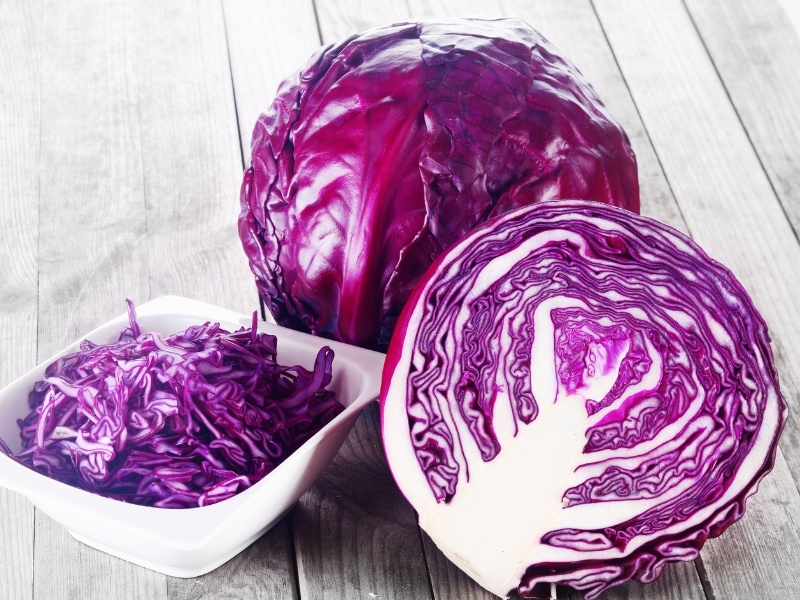
The next time you make a recipe that calls for green cabbage, try swapping in its purple counterpart instead.
It tastes similar but has more beneficial plant compounds.
Purple cabbage is a rich source of antioxidants and also helps fight inflammation.
The presence of anthocyanins also makes it a healthy addition to your diet.
You can use purple cabbage in salads, stir-fries, and soups.
It also tastes deliciously fermented as sauerkraut or kimchi.
3. Purple Cauliflower
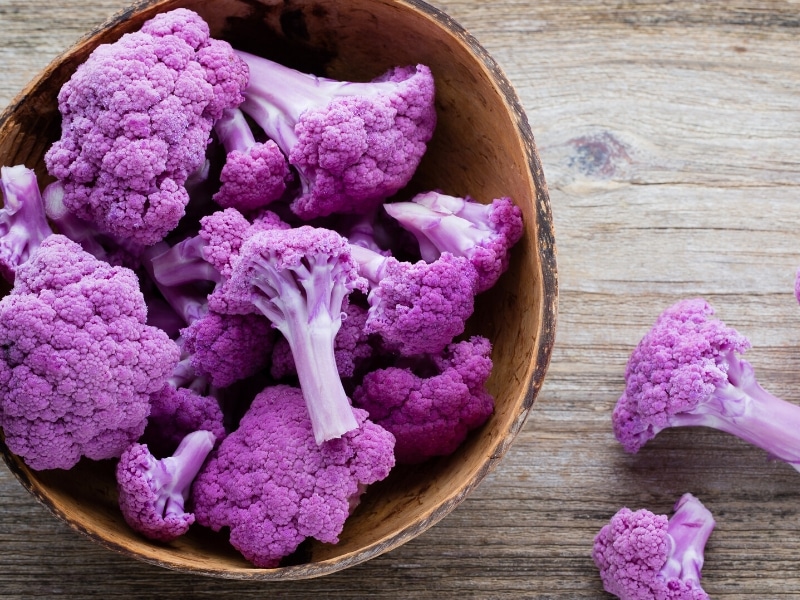
Aside from looking far prettier than white cauliflower, purple cauliflower has a more subtle sweetness in every bite.
You’ll find this unique variety tastes mildly nutty and crunchy.
The purple cauliflower is a nice addition if you want to add some color to your dish.
Just be sure you don’t cook it since it loses the purple hue when exposed to water.
4. Purple Carrots
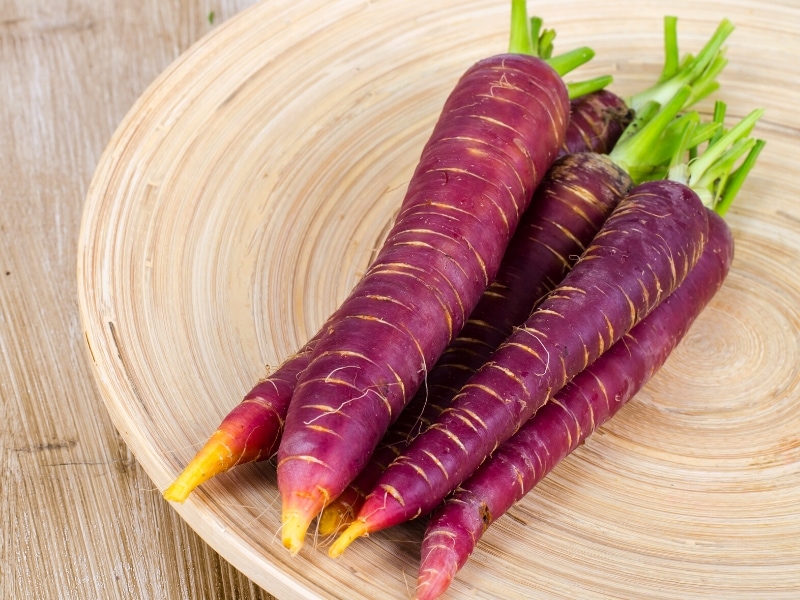
If you think carrots are just orange, think again.
They come in all colors, including white, yellow, and, you guessed it, purple!
Carrots are already a nutritional powerhouse, but purple carrots contain even more nutrients.
You’ll find the same hefty amount of Vitamin A, C, and B, along with prized anthocyanin antioxidants.
Here’s some food for thought: there’s some evidence that carrots were originally purple.
The orange ones we know and love might just be a byproduct of genetic mutation.
You can find purple carrots in specialty grocery stores and farmers’ markets.
Try roasting a batch of purple, white, and orange carrots together for a colorful display at dinner.
5. Redbor Kale
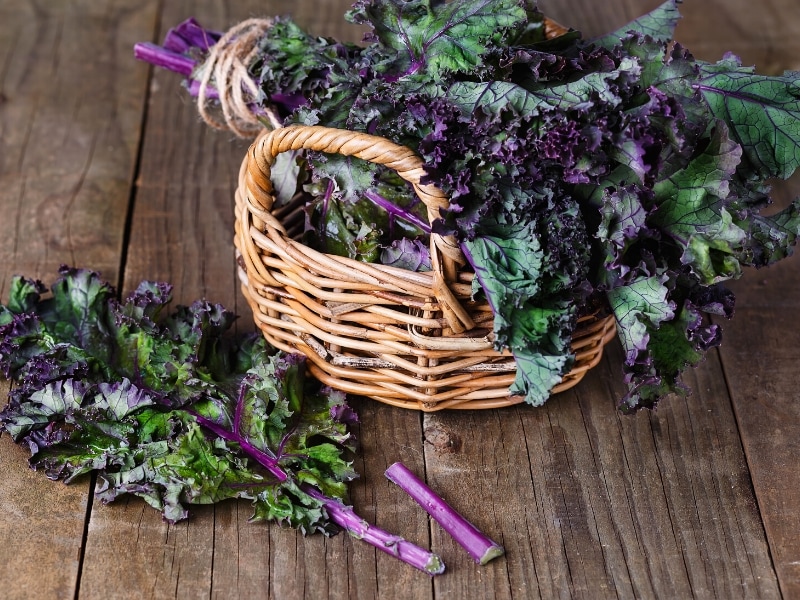
As the name suggests, redbor kale produces dark purple leaves that separate it from green kale.
This purple variety shares the same bitter, earthy flavor as green kale but with a more pleasing color.
It makes an excellent garnish that’s also highly nutritious.
Imagine sprinkling redbor kale on top of a salad to create a colorful concoction that doubles as a work of art.
6. Purple Asparagus
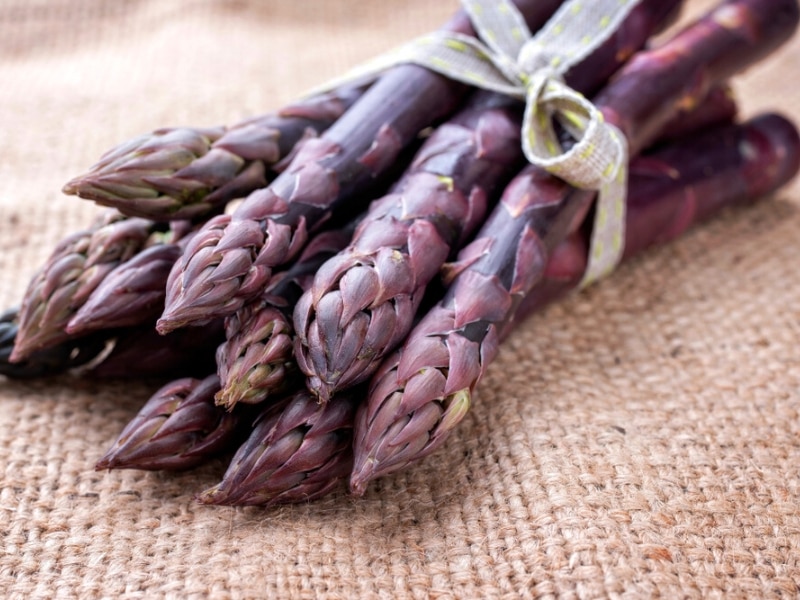
Purple asparagus might be the perfect antidote for the late winter blues.
Not only does this spring-time staple crop signify the end of winter, but it also adds some much-needed color to your diet.
The vibrant purple tinge of purple asparagus would liven up any dinner plate, especially next to a bed of leafy greens.
You can expect a flavor similar to normal asparagus.
But the purple variety has a higher amount of natural sugars with a mild nutty flavor.
7. Purple Bell Peppers

You’ve probably heard of red, orange, and yellow bell peppers, but what about purple?
These bell peppers are mild, succulent, and sweet, with a crunchy texture in every bite.
Envision serving up sliced purple bell peppers with the yellow and red variety for a colorful veggie plate.
Or you can shake up Taco Tuesday by adding these peppers to your Tex-Mex fair.
No matter what you do with purple bell peppers, you’re in for a visually stunning treat.
8. Purple String Beans
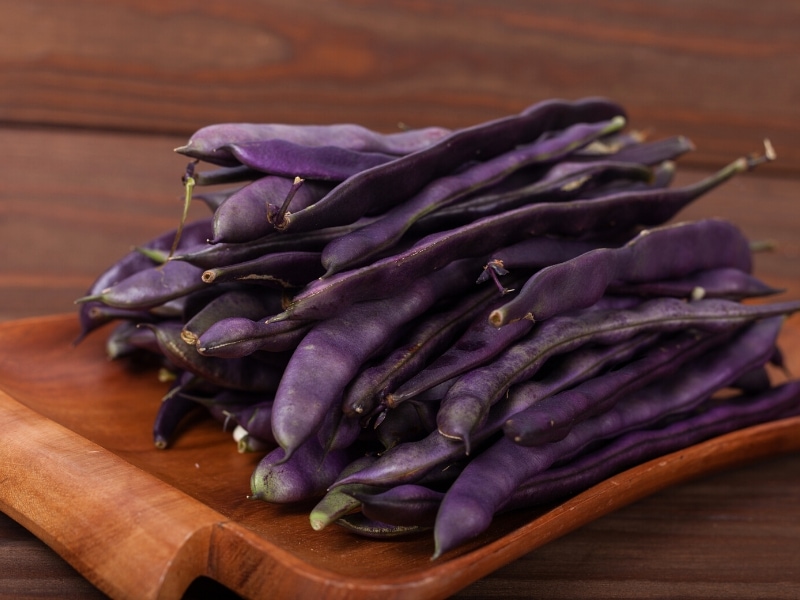
Purple string beans are basically green beans that have gone incognito in a violet disguise.
You’ll still find the same crisp texture and grassy, sweet flavor in this purple version.
The only caveat to purple string beans is that they lose their color when cooked.
You want to prepare them raw to enjoy the brilliant violet color.
Add this pretty variety to a bean salad for a pop of color, or pickle them for a salty-sweet condiment.
Whatever your chosen method, you can’t go wrong with purple string beans.
9. Magic Molly Potatoes
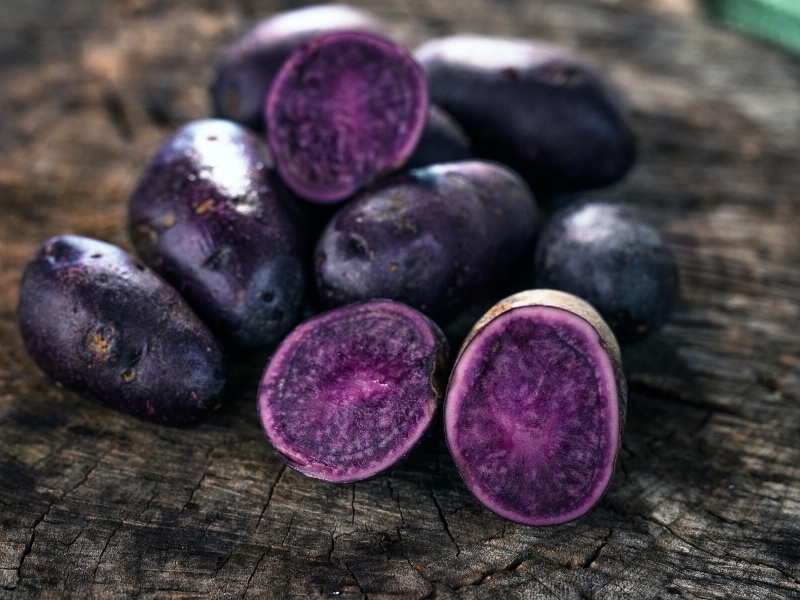
You might be wondering how this purple potato got its funky name.
In the early 21st century, a home gardening enthusiast found this unique variety growing in rural Alaska.
He cultivated the spuds for his own garden and named them after his daughter Molly. The rest is, as they say, history.
Spud lovers treasure the creamy texture and subtle sweetness in Magic Molly potatoes.
Even after cooking, these potatoes still retain their deep purple hue.
Imagine serving up a batch of these mashed purple potatoes at your next gathering.
Your dinner guests will definitely be taken aback by the beautiful color.
10. Kolibri Kohlrabi
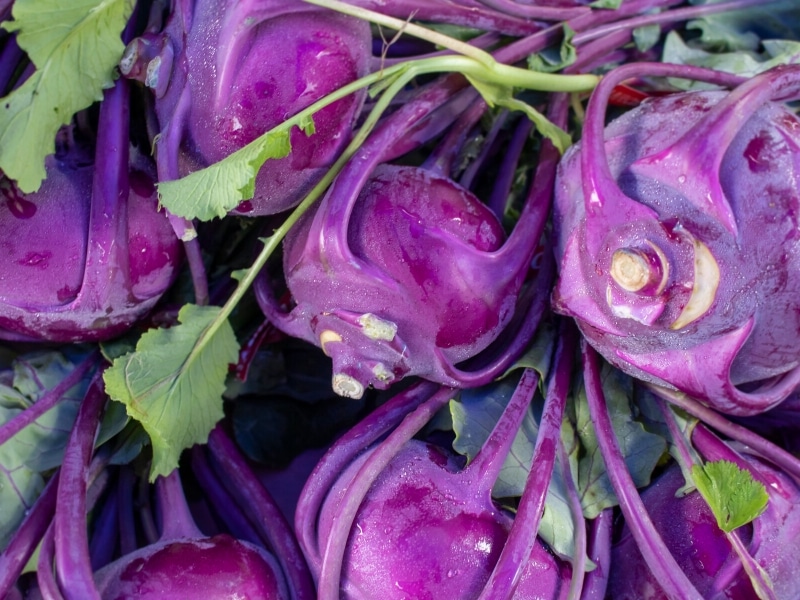
If this is the first time you’ve heard of this purple vegetable, let me introduce you.
Kolibri kohlrabi is a violet-tinged cruciferous vegetable that looks similar to a turnip.
You can eat the leaves and the stem both raw and cooked.
The texture will remind you of a crunchy apple, but the flavor tastes more like cabbage.
You can use this purple veggie raw in salads and coleslaws or cooked in stir-fries and skillet meals.
11. Purple Ruffles Basil
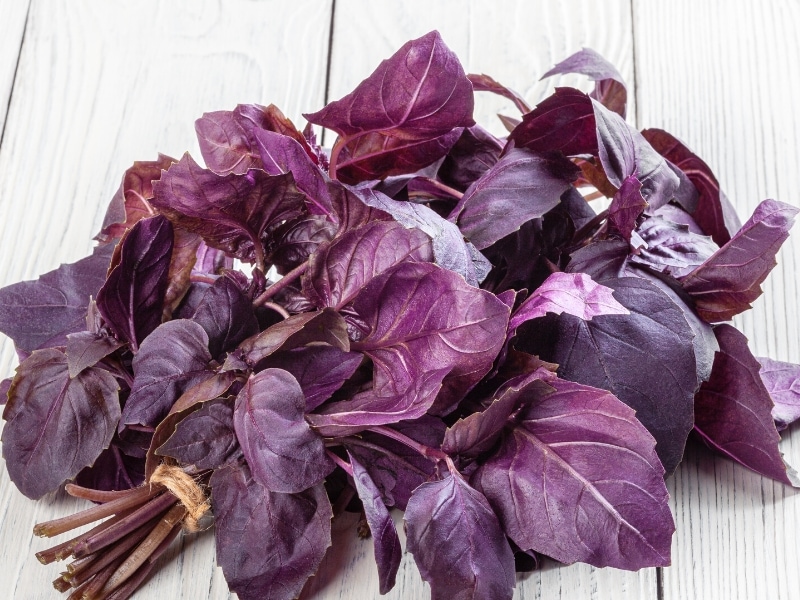
If you thought basil was only green, think again!
This zingy herb also has a violet variety that’s appropriately named purple ruffles basil.
Aside from being visually pleasing, this variation also has more licorice and cinnamon flavor, adding a unique taste to Italian dishes.
Besides, this herb variety is very easy to grow, making it perfect for a balcony herb garden.
If you love growing your own herbs for cooking, then purple ruffles basil is for you.
12. King Tut Purple Pea
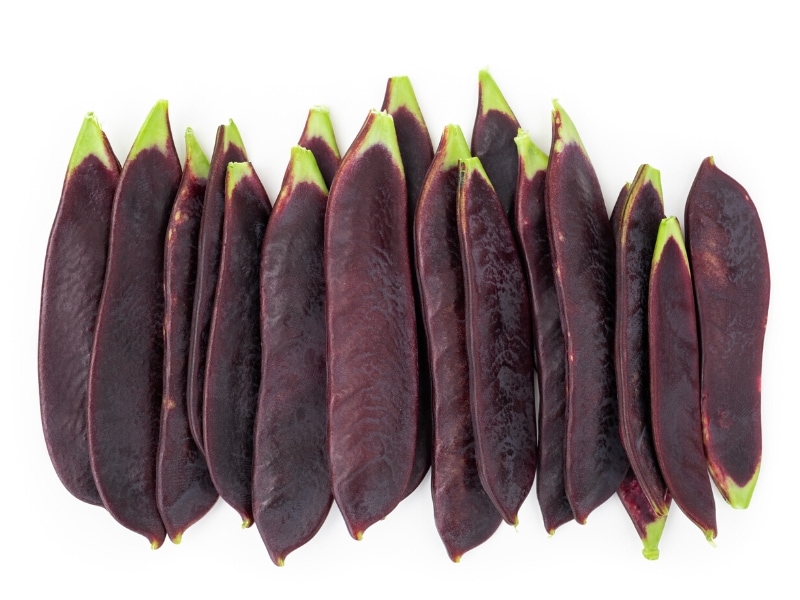
Wanna try a pea that has ties to King Tut?
Rumor has it that this purple variety was taken from the Egyptian pharaoh’s tomb after lying there undisturbed for nearly 5000 years.
After being discovered in 1922, the seeds were re-cultivated into the King Tut purple pea species.
Curious to try this piece of living history? You can eat these ancient peas either fresh or cooked.
You can also dry and store these peas, though I don’t recommend keeping them for thousands of years.
13. Purple Lady Bok Choy
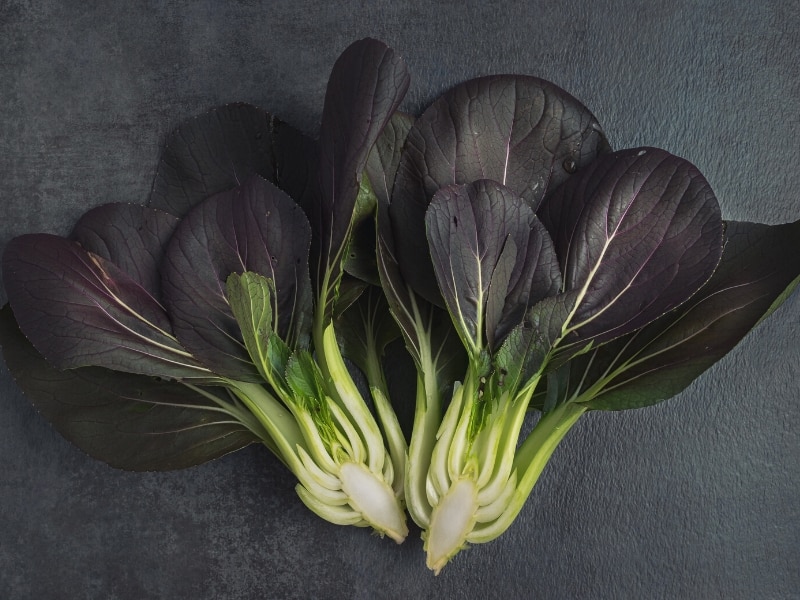
This veggie showcases majestic beauty on your dinner plate.
Purple Lady bok choy is a powerful source of vitamins C, K, A, and folate.
This species tastes mild and delicate and makes a delicious addition to stir-fries.
These purple leaves are an ideal blank slate for seasoning since they soak up flavor like a sponge.
14. Pusa Jamuni Radish
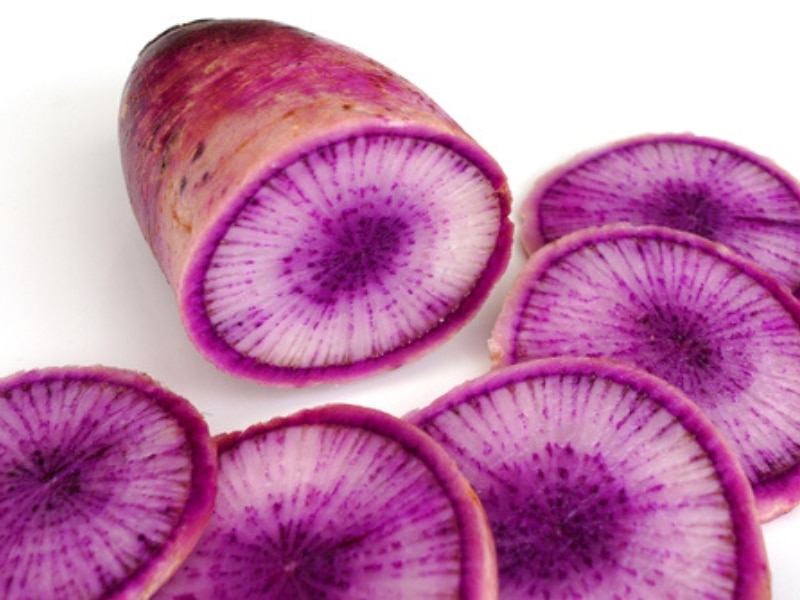
This unique radish boasts a stunning violet hue, remarkable flavor, and exceptional nutrition.
Originating in India, the Pusa Jamuni radish produces a root vegetable that carries an unusual spicy flavor.
You can cook or pickle it to reduce the pungent bite.
This variety is packed with antioxidants and vitamins, making it a healthy veggie to incorporate into your diet.
15. Purple Majesty Potato

You might be wondering why this variety is called Purple Majesty. After one look at the brilliant hue, you’ll understand its regal name.
The purple color runs deep throughout the flesh and doesn’t disappear after cooking.
You’ll find that these spuds have a moist texture and a mild sweet flavor.
Aside from being rich in anthocyanins, these potatoes have a healthy dose of Vitamin C.
They help keep your immunity boosted during cold and flu season. Purple potato soup anyone?
16. Mountain Morado Corn
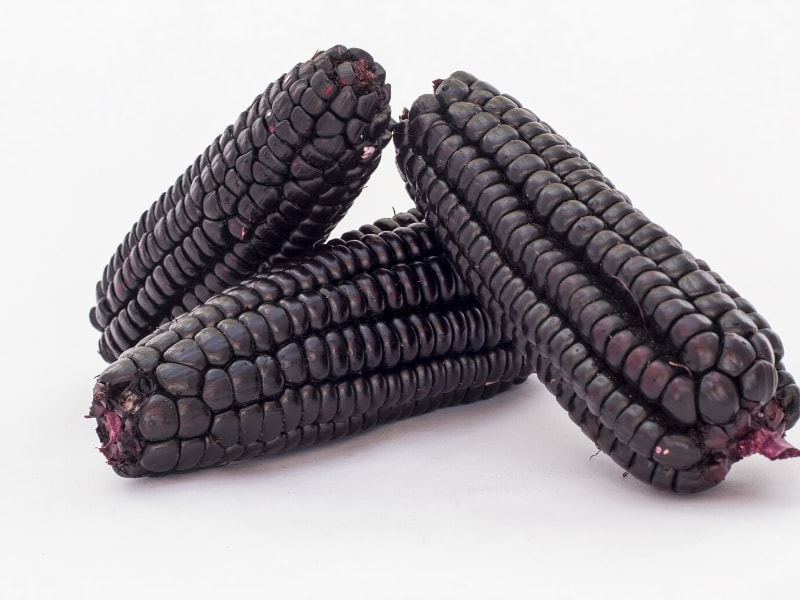
This corn looks like it came from another planet when, in reality, it actually hails from Montana!
It looks black, but it’s just a dark, rich purple.
It’s mainly grown to create an antioxidant-rich flour for tortillas and cornbread.
17. Purple Brussels Sprouts
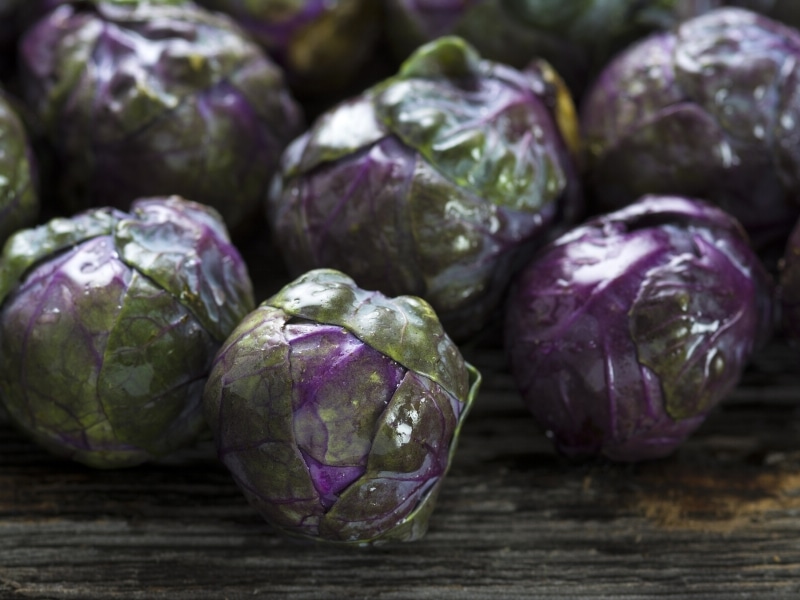
Purple Brussels sprouts are a genius way to trick picky eaters into eating more vegetables.
They look insanely neat with a cool green-purple pattern that looks otherworldly.
These purple sprouts are a byproduct of crossbreeding green Brussels sprouts with red cabbage.
The flavor is slightly sweeter and less sharp than their green counterparts.
Purple Brussels sprouts tend to cook faster since the leaves aren’t as tightly packed.
When combined with heat, the purple color turns blue or brown.
18. Purple Onions
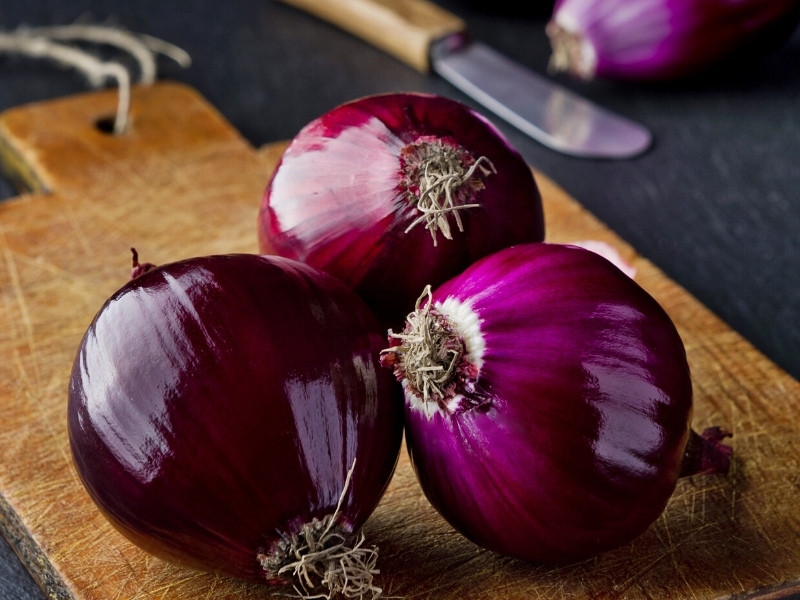
You might think that purple onions look an awful lot like red onions.
Well, I have a confession: they’re the same variety but with different names depending on where you live.
In America, these alliums go by the name red onions, whereas in Europe, they’re called purple onions.
If you ask me, the skin looks more purple than red to me, but maybe that’s my personal bias.
In any case, these onions burst with sharp flavors that make them perfect for cooking and eating raw.
They’re also the healthiest onion variety since the purple hue equates to more antioxidants.
19. Purple Artichokes
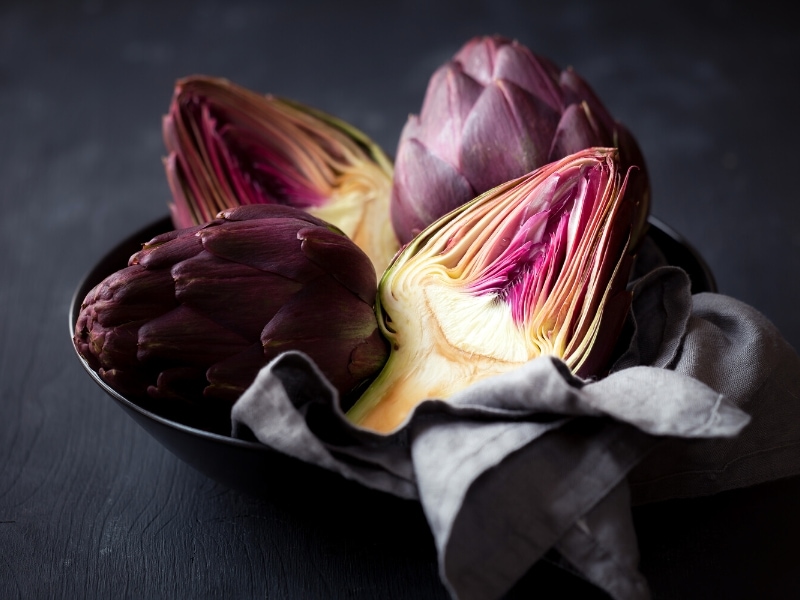
You can find this vibrant artichoke during spring for a very short time, so be sure to try it out next growing season.
This variety has big, meaty leaves that become tender when cooked.
You’ll appreciate the rich, earthy flavor in each bite.
A fantastic feat of a purple artichoke is that it carries many gut-friendly properties thanks to its high fiber content.
You’ll also find a high source of protein in this vegetable, which makes it stand out from other edible cruciferous plants.
20. Detroit Dark Red Beet
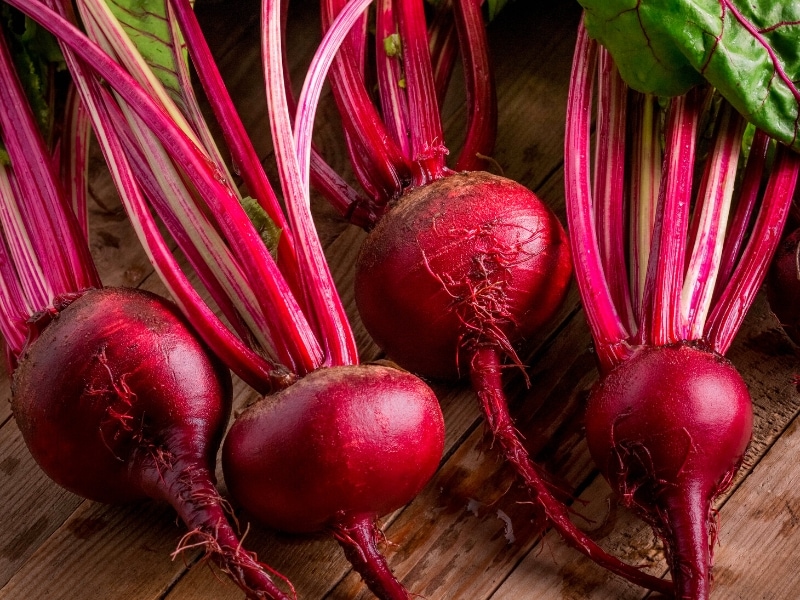
The Detroit dark red beet is the optimal all-purpose beet.
Whether you want to use it in canning, salads, pickles, or soups, this variety can do it all!
The Detroit dark red beet was introduced in 1892 by D.M Ferry Seed Company and touted for having the best shape and smoothest roots.
It’s easy to grow and has a vigorous output, which has made it a mainstay in American supermarkets.
21. Dragon Tongue Beans
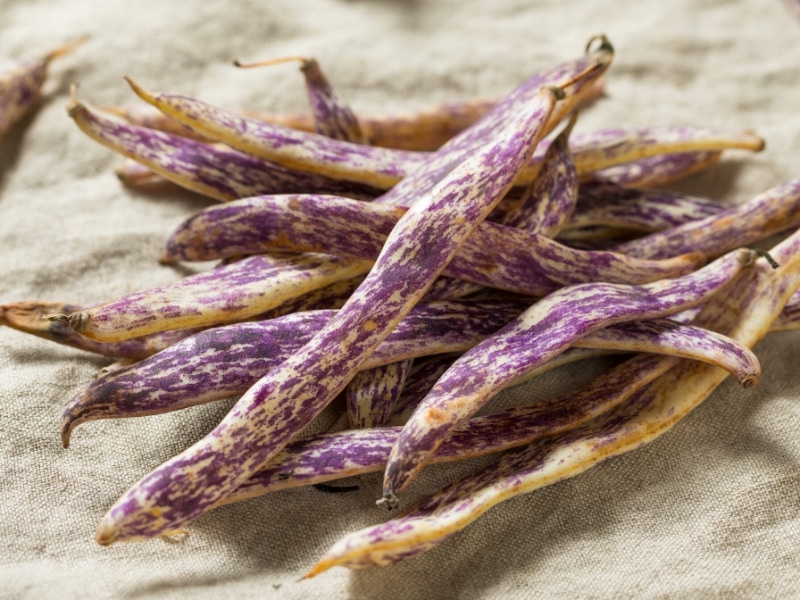
Dragon tongue beans are known for their eye-catching bright purple streaks that mingle with the yellow base color.
This Dutch heirloom variety dates back to the 19th century and also goes by the name Merveille de Piemonte.
These beans are tender with a familiar grassy flavor likened to green beans.
They’re kid-approved veggies that appeal to all the senses.
22. Garnet Giant Mustard
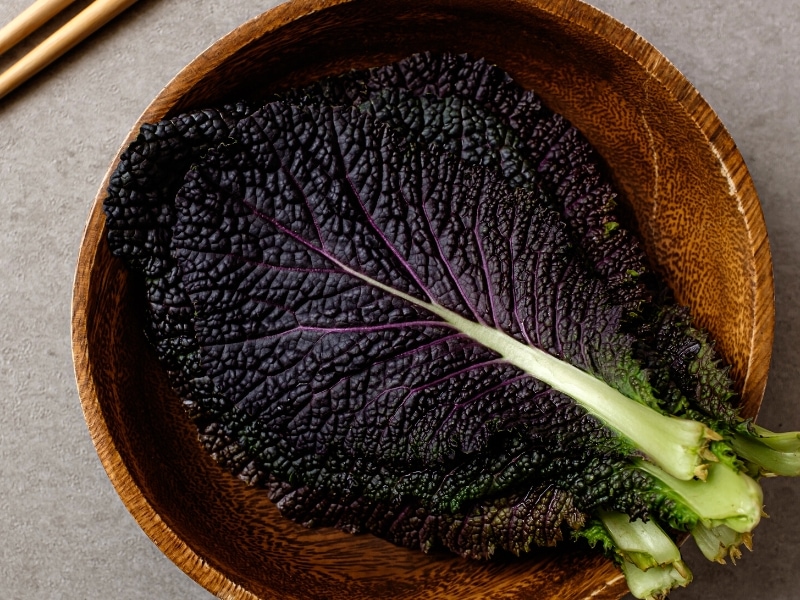
Are you tired of the same old herbs? If so, check out garnet giant mustard to shake up your seasonings.
You can use this small leafy green as a fabulous micro-green garnish for avocado toast or salads.
Or toss a handful in a stir-fry or soup for a pungent flavor.
This purple veggie is the spiciest mustard variety and has an intense horseradish flavor.
23. Purple Rutabagas
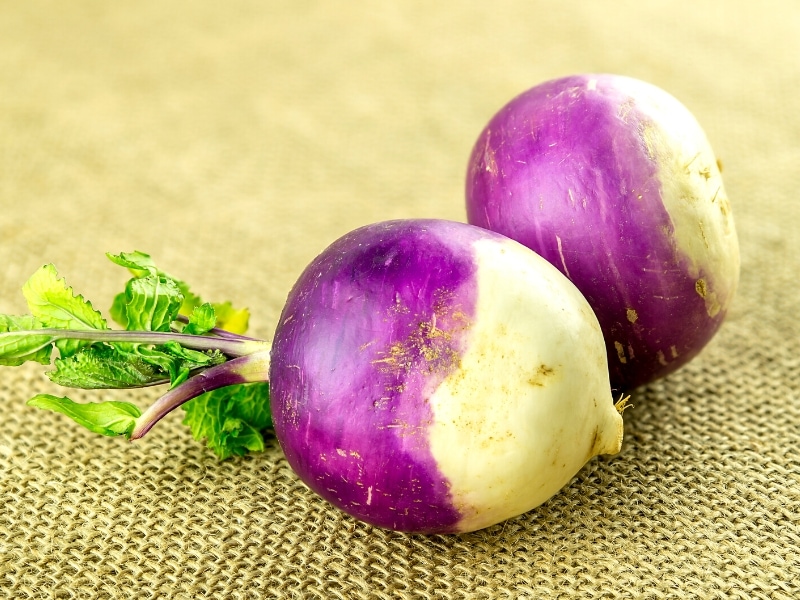
Purple rutabagas are an heirloom crop that originated in the early 20th century.
If you ever attend a Midwest farmers market in the fall, you’ll likely see these large purple roots on display.
They have an artful dual-colored skin that ranges from white to violet.
While you can eat this rutabaga variety raw, it’s much better cubed, stewed, or mashed.
